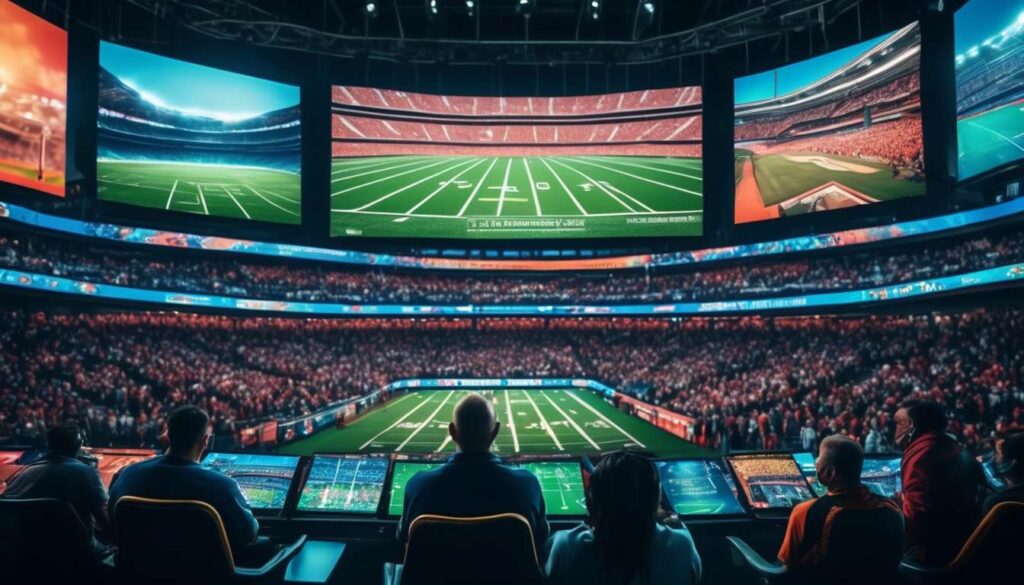As avid sports fans, we’ve noticed a significant shift in how broadcasts are presented. Every time we settle in to watch a game, we’re met with a barrage of sports betting advertisements. This phenomenon isn’t just a fleeting impression; it’s a trend that’s reshaping the viewing experience.
We often find ourselves wondering just how much of the broadcast is dedicated to these ads. It’s not just a question of curiosity but a matter of understanding how the landscape of sports entertainment is evolving. With the rise of legalized sports betting, these advertisements have become a staple.
But at what cost to the traditional viewing experience? In this article, we aim to:
- Delve into the data.
- Explore the percentage of airtime occupied by these adverts.
- Consider the implications for both the industry and us, the viewers.
Let’s uncover the reality behind the screen time devoted to sports betting.
The Rise of Sports Betting Advertisements
In recent years, we’ve seen a significant surge in sports betting advertisements across various media platforms. This trend has transformed the landscape of sports broadcasting, as betting companies capitalize on the love we share for sports.
Sports betting has become a prominent feature during broadcast airtime, integrating seamlessly into our shared viewing experiences. These ads appeal to us by creating a sense of community and excitement, drawing us into the thrill of predicting game outcomes along with fellow fans.
As sports enthusiasts, we often find ourselves surrounded by these ads, whether we’re watching from the comfort of our homes or attending live events.
The rise of sports betting advertisements reflects a shift in how we engage with sports content. It’s more than just watching a game; it’s about participating in a larger narrative.
This evolution in advertising aims to enhance our viewer experience by:
- Making us feel more connected to the action.
- Fostering a sense of community through shared hopes and predictions.
- Encouraging active participation in the sports narrative.
Impact on Viewer Experience
As sports fans, we’ve noticed how betting ads significantly alter our viewing experience by making it more interactive and engaging. Sports betting integrates seamlessly into our favorite broadcasts, creating a shared atmosphere where we feel more connected to the action.
The thrill of predicting outcomes and the chance to participate in real-time decisions foster a sense of camaraderie among viewers.
However, there’s also a balance to be struck. While sports betting can enhance our experience, its prevalence during broadcast airtime can sometimes feel overwhelming. We might find ourselves distracted from the game itself, as the constant flashing of odds and promotions competes for our attention.
Within our community, these ads have sparked conversations and debates that bring us closer. They’ve become a part of our social fabric, influencing how we watch and interact with sports.
Ultimately, sports betting ads have reshaped our viewer experience, blending entertainment with anticipation and a sense of belonging.
Examining Broadcast Airtime Data
Analyzing the Allocation of Broadcast Airtime
A significant portion of broadcast airtime is dedicated to sports betting advertisements. As we delve into the data, it becomes evident how intertwined sports betting and sports broadcasts have become. This is not merely a trend but a strategic choice by networks to capitalize on the growing popularity of betting.
Networks’ Strategic Choices
Networks are keen to enhance our viewer experience by tapping into our shared passion for sports:
- Sports betting ads are designed to engage viewers.
- These ads aim to increase viewer interaction with sports events.
Impact on the Essence of the Game
With so much airtime devoted to these ads, questions arise about the impact on the essence of the game. Are we witnessing more of the commercial side than the actual sports action? As a community of sports enthusiasts, we must consider:
- The thrill of the game itself.
- The necessity to balance viewer experience with the frequency of sports betting promotions.
Navigating the Evolving Landscape
It’s crucial to find a balance that enriches our viewer experience without overwhelming us with constant sports betting promotions. Together, we can navigate this evolving landscape to maintain the integrity and excitement of sports broadcasts.
Analysis of Advertising Trends
In our analysis of advertising trends, we notice a significant shift towards integrating sports betting ads into the regular programming of sports broadcasts. This change isn’t just about filling broadcast airtime; it reflects a broader cultural acceptance of sports betting as part of the viewer experience.
We recognize that these ads are becoming a staple, seamlessly woven into the fabric of the game, much like halftime shows and post-game analysis.
Our shared experience as fans means:
- We’re all seeing the same game.
- We’re exposed to the same ads.
- We feel the same excitement when those odds flash on the screen.
It’s a communal moment, one that can enhance our connection to the sport and each other.
However, we must ensure that this integration doesn’t overshadow the essence of the game itself. By understanding these trends, we can better navigate this evolving landscape and maintain the balance between enhancing viewer experience and preserving the core of sports broadcasts.
Evolution of Sports Entertainment Landscape
Over the past decade, we’ve witnessed a dramatic transformation in the sports entertainment landscape, driven by technological advancements and shifting viewer preferences.
The Rise of Sports Betting
The rise of sports betting has played a pivotal role in this evolution, reshaping how we engage with our favorite teams and athletes. As we gather in living rooms or online communities, the thrill of placing a bet enhances our connection to the games, making each moment more intense and personal.
Integration into Broadcast Airtime
Broadcast airtime has adapted to this change, integrating sports betting into the viewer experience.
We now see:
- Odds displayed alongside scores
- Commentators frequently discussing betting lines, weaving them seamlessly into their narratives
This shift not only caters to seasoned bettors but also invites newcomers to join the excitement, fostering a sense of belonging within the broader sports community.
Together, we embrace these changes, knowing that our shared passion for sports continues to unite us, even as the landscape evolves around us.
Implications for Sports Industry
The rapid integration of betting into sports broadcasts is transforming industry dynamics, creating new revenue streams and altering traditional fan engagement.
As sports betting gains traction, we’re witnessing a shift in how broadcast airtime is utilized, with a significant portion now dedicated to betting advertisements. This change isn’t just about business; it’s about how we, as a community of fans, experience sports.
By incorporating sports betting into the mix, broadcasters are tailoring the viewer experience to be more interactive and engaging. We find ourselves not just watching the game but also participating in it, forging a deeper connection with the sports we love.
As we embrace these changes, the sports industry is positioned at the forefront of entertainment innovation, leading to:
- Increased viewer involvement
- Expanded economic opportunities
Let’s continue to support and adapt to these innovations, ensuring our favorite sports remain exciting and relevant in an ever-evolving landscape.
Together, we redefine what it means to be sports fans.
Viewer Perception and Engagement
Many fans are finding that the inclusion of betting elements enhances their engagement and emotional investment during live sports broadcasts.
As we gather around our screens, sports betting adds an exciting layer to our viewer experience. We feel a part of something bigger, sharing the thrill and anticipation with fellow fans as the game unfolds. The strategic placement of betting advertisements during broadcast airtime keeps us on our toes, inviting us to dive deeper into the action.
Our shared experiences of cheering or groaning over a bet’s outcome create a sense of community. We find ourselves discussing odds and predictions with friends and strangers alike, fostering connections over our mutual passion.
Yet, it’s crucial that the balance between sports content and advertising is maintained. Too much emphasis on sports betting could overshadow the very games we love.
As we navigate this evolving landscape, our collective voice can ensure that broadcasts remain enjoyable and inclusive for everyone.
Future of Sports Broadcast Advertising
As we look to the future of sports broadcast advertising, it’s clear that innovation will play a pivotal role in shaping how we interact with live sporting events. We’re on the brink of a transformative era where sports betting seamlessly merges with viewer experience.
Imagine a world where broadcast airtime isn’t just filled with static ads but is an interactive playground, enhancing our connection to the games we love.
We’re likely to see more personalized content, where sports betting offers are tailored to our preferences, enriching our viewing experience. This dynamic shift means that advertisers will no longer compete for mere seconds of our attention. Instead, they’ll create engaging narratives that:
- Resonate with our sense of community
- Appeal to our passion for sports
Together, as fans and broadcasters, we’ll redefine the way we connect with live events, ensuring that every moment spent watching is more than just entertainment. It’s an opportunity to belong to a vibrant, interactive sports community.
Conclusion
In conclusion, sports betting advertising now occupies a significant portion of airtime during typical sports broadcasts, with approximately 20% of screen time devoted to such promotions.
This trend reflects a shift in the sports entertainment landscape, impacting:
- Viewer experience
- Industry dynamics
Moving forward, the sports industry will need to navigate the implications of this advertising evolution on:
- Viewer perception
- Engagement
- The overall future of sports broadcast advertising.
This evolution signifies a pivotal moment in how sports broadcasts are consumed and the strategies stakeholders must consider.

